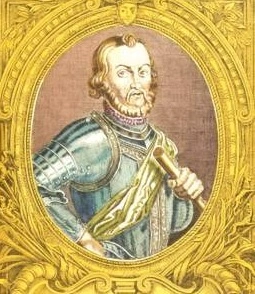voyage de Cortes
Publié le 03/04/2016

Extrait du document

REASONS: Cortes actually studied law and wanted to become a lawyer at first. But at age 19 in 1508, he sailed to Hispaniola in the Caribbean, his family paying for him to sail to the "new world" . The Spanish learned about Aztec wealth and sent an expedition to establish a port as a trading base. HC used this opportunity and without any order set off to conquer the empire with only 400 foot soldiers and 15 horsemen (horses and guns of the Spaniards terrorized and intimidated Indian opponents) The island was considered a holy place, even by the inhabitants of the mainland, who came to it in great processions. Cortez, seeing this, determined to convert the natives to the true faith by changing their god. At first, the people objected, telling him their gods had always been very good to them, sending rain when it was needed, and crops of corn to the people of Yucatan, who came over and offered gifts at their altars. His goal was to conquer the Aztecs in the name of the Spanish Empire (colonies in different places) After a few battles with the natives, Velazquez rewarded Cortez for his boldness in battle by making him the governor of Cuba and letting him marry his sister-in-law. 1518 Velazquez sponsored/paid for an expedition to Mexico (Yucatan area) and he sailed in 1519 with eleven ships. He heard of the Aztecs got that gold fever. The one that makes people kill natives. Moved his fleet to Vera Cruz and burned all his ships. He did this so his men would not desert and took a native mistress so he could use there tribe to supplement his force to conquer to Aztecs. With a force of 600 men, twenty horses, 10 small cannon, he conquered a race of 5 million and took all their wealth. He sailed to Tenochtitlan in 1521 to take on some Aztecs hold outs and wiped them out. To gain favor with the king of Spain, he sent a lot of gold to Spain and gained the kings favor and was given the governorship of all Mexico. He sailed and led and expedition to Honduras in 1524. The court of Spain were scared of his ambitions as was the King who revoked his governorship in 1528. Cortes burned his ships after he landed at Vera Cruz so that his troops could not turn back. CONSEQUENCES: Though his initial military attack in 1518 failed (he may have had guns, but not numbers), he unintentionally unleashed smallpox on Tenochtitlan, the Aztec capital (now Mexico City), which made it possible for swift military victory (Cortes thought the smallpox had been sent by God). He thus established a reputation as the most brutal of the Conquistadores. The Spanish brought with them small-pox and half of the Indians died of this illness. He also ruined Aztec culture and history. However, in the 15th century their empire was declining due to internal weakness and the opposition of neighboring tribes. The Aztecs were highly unpopular because of their cruelty, human sacrifices and harsh rule. Subjugated tribes hated the Aztecs and some, such as the Tlaxcala, became the willing allies of Cortes. He spent much of his later years seeking recognition for his achievements and support from the Spanish royal court. He built Mexico City on the Aztec ruins. He introduced many positive aspects into Aztec ways of life like horses, sheep, cattle and different types of grains and foods. The Emperor Montezuma When Montezuma II (c.1502-1520), the leader of the Aztecs, heard of Cortes’s approach, he first lavished gifts on the Spaniards, which only served to whet the appetite of Cortes for conquest. When the gifts did not serve as a deterrent, Montezuma permitted Cortes to enter the capital in November 1519 and received him at court. Cortez then took him prisoner and ruled in the name of Montezuma. In the end Cortez was given the title of Governor of New Mexico by the Spanish king. Not only did the conquered peoples pay tribute in food and precious metals, but also in human prisoners who were sacrificed to the Aztec god.
Liens utiles
- Géopolitique de l'Automobile, Économie du Marché Automobile et Évolution : Un Voyage de 1970 à 2022
- Synthèse : extrait 5 "Supplément au voyage de Bougainville" de Diderot
- anthologie sur le voyage
- Le voyage selon Jacques Lacarrière (1925-2005)
- Expliquez le passage suivant du Voyage en Amérique de Chateaubriand ( 1791, publié en 1827) el relevez dans celle description d'une nuit passée dans la forêt vierge les traits caractéristiques nouveaux et qui annoncent le romantisme











